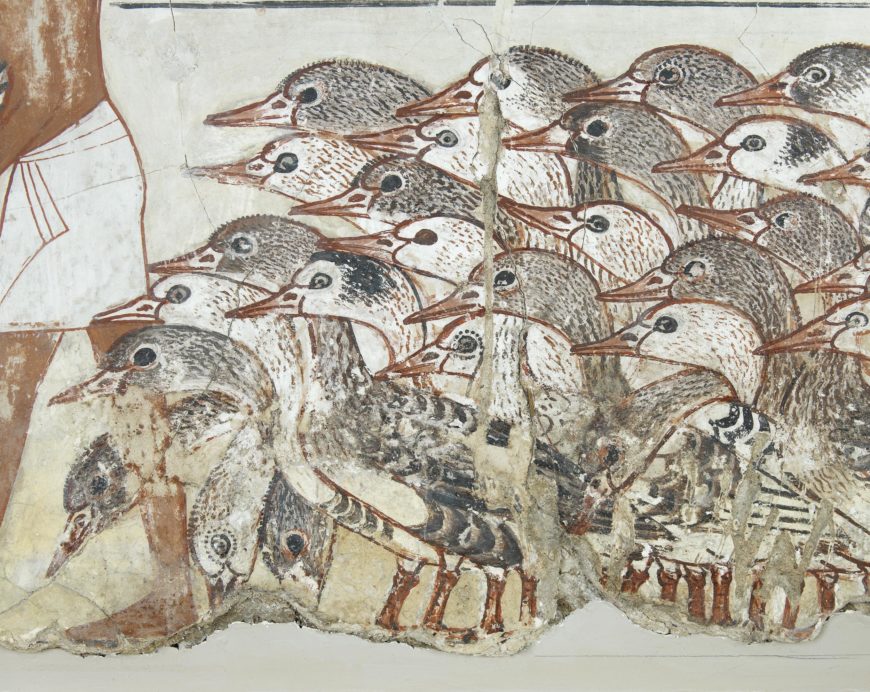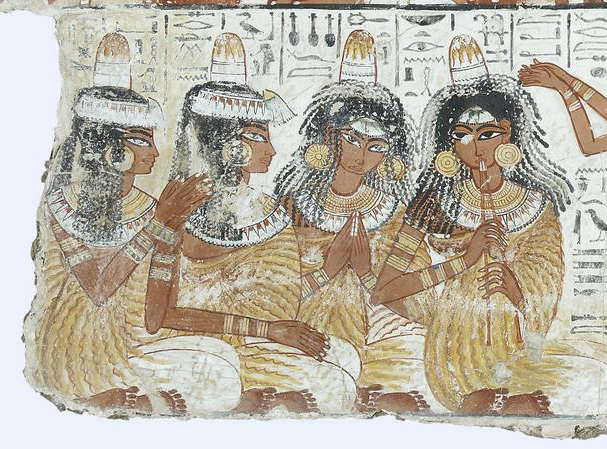
Geese (detail), from the Presentation of the Geese , Tomb chapel of Nebamun, c. 1350 BCE, paint on plaster, whole fragment: 71 x 115.5 cm, Thebes © Trustees of the British Museum
The British Museum contains 11 fragments of wall painting, which are some of the most famous images of Egyptian art. The fragments come from the now lost tomb-chapel of Nebamun, an ancient Egyptian scribe or the “scribe and grain accountant in the granary of divine offerings,” in the Temple of Amun at Karnak. Nebamun died c. 1350 BCE, a generation or so before Tutankhamun. His name is damaged but he was almost certainly called Nebamun.
“Antiquity’s equivalent to Michelangelo”
The tomb-paintings were discovered by the local agent Henry Salt in Thebes and acquired by the Museum in the 1820s. The location of the tomb from which they came is still not known with any certainty, but it is thought to be in the northern part of the necropolis in the area known as Dra Abu el-Naga. Stylistically, the magnificent wall paintings can be dated to either the final years of the reign of Amenhotep III (1390–1352 BCE) or the early years of his successor. The fragments were constantly on display until the late 1990s. Since then, the fragile wall-paintings have been meticulously conserved, securing their condition for at least the next fifty years.
The project has provided numerous new insights into the superb technique of the painters. Their exuberant compositions, astonishing depictions of animal life and unparalleled handling of textures have caused one art historian to call them “antiquity’s equivalent to Michelangelo.” New research and scholarship have enabled new connections to be made between the fragments, allowing scholars to gain a better understanding of their original locations in the tomb. They will now be re-displayed together for the first time in a setting designed to recreate their original aesthetic impact and to evoke their original position in a small intimate chapel.

The four musicians and singers with their song written above them (detail), Banquet Scene , Tomb Chapel of Nebanum, c. 1350 BCE, 18th Dynasty, paint on plaster, whole fragment: 88 x 119 x 22 cm, Thebes © Trustees of the British Museum
The paintings show scenes of daily life and include images of banquets, agriculture, animal husbandry, hunting and scenes of offerings. The quality of the drawing and composition is outstanding, and the superbly detailed treatment of the animals makes these some of the finest paintings to survive from ancient Egypt.
A place of commemoration
Nebamun’s tomb-chapel was a place for people to come and commemorate Nebamun and his wife after his death with prayers and offerings. Nebamun himself was buried somewhere beneath the floor of the innermost room of the tomb-chapel in a hidden burial chamber.The beautiful paintings, which decorated the wall, not only showed how Nebamun wanted his life to be remembered but what he wanted in his life after death.
Building a tomb-chapel was expensive and would have only been done by the wealthy. The majority of ancient Egyptians would have been buried in cemeteries.
How the tomb-chapel was built and used
Nebamun’s tomb-chapel was cut into the desert hills opposite the city of Thebes (modern Luxor and Karnak). Workmen would have cut the tomb out of the rock using flint tools and copper-alloy chisels. The walls and ceilings of the tomb were then covered in a layer of mud plaster, followed by a layer of white plaster. This provided a smooth surface for painting.
The tomb-chapel was painted by a team of artists. They first sketched out the designs and figures before painting the final pattern. Sometimes the sketches can still be seen, showing how the artists changed their minds. The artists used black, white, red, yellow, blue and green paints.
The tomb-chapel probably contained three sections: an outer chamber, an inner chamber and an underground burial chamber, which was sealed once Nebamun and his wife had been buried. Outside the tomb-chapel a courtyard was cut into the hillside. The walls of the chapel facade were decorated with rows of pottery cones stamped with the names and titles of the owner.
Additional resources
M. Hooper, The Tomb of Nebamun (London, British Museum Press, 2007).
R. Parkinson, The painted Tomb-chapel of Nebamun (London, British Museum Press, 2008).
A. Middleton and K. Uprichard, (eds.), The Nebamun Wall Paintings: Conservation, Scientific Analysis and Display at the British Museum (London, Archetype, 2008).
Explore the tomb-chapel of Nebamun in a 3D interactive animation at The British Museum
© Trustees of the British Museum

